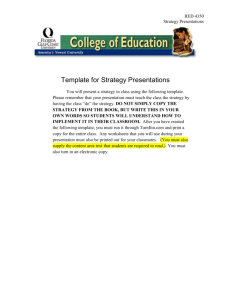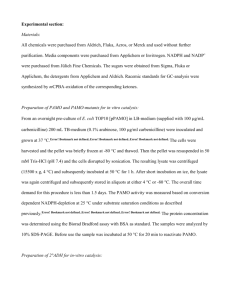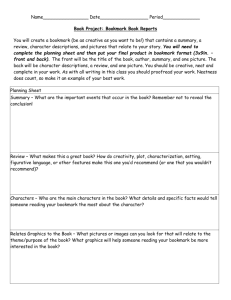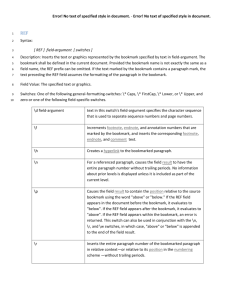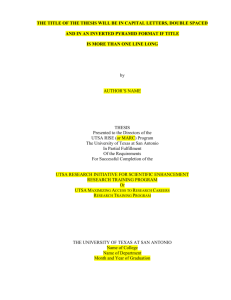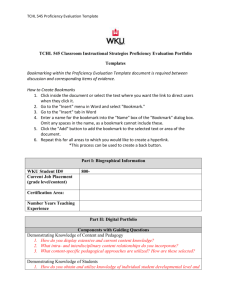View - DBA in a Box
advertisement
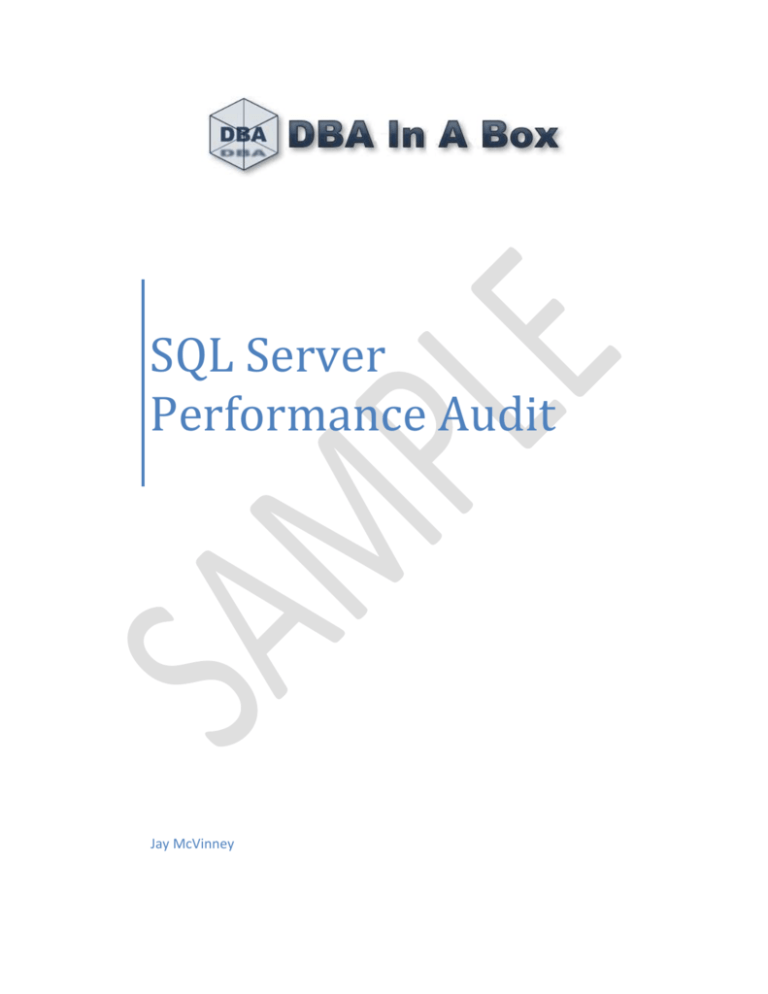
SQL Server Performance Audit Jay McVinney Contents Summary ......................................................................................................................................... 4 SQL Server Performance Audit Overview ................................................................................... 4 Executive Summary......................................................................................................................... 5 Critical Tasks with no Infrastructure Expense............................................................................. 6 Critical Tasks with Infrastructure Expense .................................................................................. 6 Non-Critical Tasks with no Infrastructure Expense..................................................................... 6 Non-Critical Tasks with Infrastructure Expense .......................................................................... 6 Complete Roadmap ........................................................................................................................ 7 Current Configuration ...................................................................... Error! Bookmark not defined. Hardware Current Configuration ................................................. Error! Bookmark not defined. CPU ........................................................................................... Error! Bookmark not defined. Memory.................................................................................... Error! Bookmark not defined. Disk Controllers ........................................................................ Error! Bookmark not defined. Storage Details ......................................................................... Error! Bookmark not defined. Network Interface Cards .......................................................... Error! Bookmark not defined. Windows Server Current Configuration ...................................... Error! Bookmark not defined. Disk Fragmentation Level......................................................... Error! Bookmark not defined. SQL Server Current Configuration ............................................... Error! Bookmark not defined. Findings and Recommendations ...................................................... Error! Bookmark not defined. Methodology................................................................................ Error! Bookmark not defined. Infrastructure ............................................................................... Error! Bookmark not defined. CPU ........................................................................................... Error! Bookmark not defined. Memory.................................................................................... Error! Bookmark not defined. Disk Storage ............................................................................. Error! Bookmark not defined. Network ................................................................................... Error! Bookmark not defined. Operating System......................................................................... Error! Bookmark not defined. Virtualization ............................................................................ Error! Bookmark not defined. Configuration ........................................................................... Error! Bookmark not defined. Database Server ........................................................................... Error! Bookmark not defined. User Connections ..................................................................... Error! Bookmark not defined. Location of SQL Server Executables ......................................... Error! Bookmark not defined. Location of System Databases ................................................. Error! Bookmark not defined. Location of the tempdb Database ........................................... Error! Bookmark not defined. Location of User Databases ..................................................... Error! Bookmark not defined. Configuration Settings ............................................................. Error! Bookmark not defined. Locks, blocks, and Latches ....................................................... Error! Bookmark not defined. SQL Agent ..................................................................................... Error! Bookmark not defined. Failed Maintenance Plans (Jobs).............................................. Error! Bookmark not defined. Failed Jobs ................................................................................ Error! Bookmark not defined. Never Ending Jobs .................................................................... Error! Bookmark not defined. Database Configuration ............................................................... Error! Bookmark not defined. Current Settings ....................................................................... Error! Bookmark not defined. Recovery Model ....................................................................... Error! Bookmark not defined. Clustered Indexes..................................................................... Error! Bookmark not defined. Duplicate Indexes ..................................................................... Error! Bookmark not defined. Rebuilding Indexes ................................................................... Error! Bookmark not defined. Security ........................................................................................ Error! Bookmark not defined. SQL Injection ............................................................................ Error! Bookmark not defined. Use of the SA account .............................................................. Error! Bookmark not defined. Object Level Security................................................................ Error! Bookmark not defined. User Accounts with matching passwords ................................ Error! Bookmark not defined. Attack Vectors .......................................................................... Error! Bookmark not defined. Access to system databases ..................................................... Error! Bookmark not defined. Sample Databases .................................................................... Error! Bookmark not defined. Application Access ....................................................................... Error! Bookmark not defined. Table Width .............................................................................. Error! Bookmark not defined. Direct Table Access .................................................................. Error! Bookmark not defined. Opening, Reusing, and Closing Connections............................ Error! Bookmark not defined. Summary The database assessment is a review of the data architecture and its current implementation across existing databases. It examines the physical implementation from SQL Server configuration to physical implementation of database files, server settings and configuration, database administration including database backup and recovery, and some issues specific to clustered environments. Performance and stability are iterative processes and changes are generally made followed by monitoring. Special attention is paid to integration of internal reporting systems to the centralized database. The goals of this assessment are to provide you with the information you need to: Provide a stable production environment Improve quality as perceived by their clients and user community Increase system uptime and reliability Decrease the business risk of lost knowledge and data Leverage the best use of funding for the right hardware Decrease the amount of unplanned time that is currently devoted to fighting fires by development and support personnel SQL Server Performance Audit Overview Database Performance Audits generally are iterative and evaluate the system as a whole to determine specific performance bottlenecks and to be proactive in regard to scaling and capacity planning. Initial analysis usually is followed by coarse adjustments to bring the system operability range away from the edge of unacceptable performance. These adjustments may include hardware changes or additions, configuration changes, or other initial measures that may be critical changes in code. Once this first phase of coarse adjustments are determined and implemented, an iterative evaluation will then reveal the less critical and finer adjustments that will then be defined and implemented. The basic changes and order of changes implemented may be refined as new information is available or in the case that a severe bottleneck is found. The individual phases will be in the form of a checklist to help identify any obvious performance problems with the SQL Server installation(s). This checklist will help identify the issues which are most easily resolved and which have the largest impact. Once these issues are properly accounted for and resolved the more complex SQL Server performance problems can be addressed. Optimal configurations rarely have defined absolutes when it comes to performance tuning. While one particular performance‐tuning tip may help boost performance one way, this same tip may hurt performance in another way. The broad categories for the initial audit are: Using various tools to aid in identifying SQL Server bottlenecks Server Hardware Performance Checklist Operating System Performance Checklist SQL Server 2005 Configuration Performance Checklist Database Configuration Settings Performance Checklist Items below were out of scope for the initial assessment: Backups, high availability, recovery Application and Transact‐SQL Performance Checklist Data Architecture Workflow Assessment Application Assessment Testing and Optimizing Executive Summary A database audit was performed on the database server at from _________ through ________. Overall, the server characteristics show that the server is underutilized and is suffering only minor issues with performance. The only major bottleneck detected was file I/O. Most of the performance related recommendations revolve around disk configuration and physical separation of data, log and system files. The relatively large number of databases will result in database management issues if the server is used for future needs. A future consideration may be that, when a project needs powerful server hardware, this server is a candidate for replacement with a less expensive server and the existing hardware can be repurposed to fill the need for the project to lower overall costs. External security on the server is very good with access being blocked to all unauthorized access at the network level. Internal security shows many opportunities for improvement which are detailed below. These opportunities for improvement have impact to both internal and external security. The server shows vulnerability to external threats via leapfrog type attacks where an external threat exploits a server that is exposed externally and uses the exploited server to attack internal assets which are normally protected from external access. The most notable security issues are the installation of SQL Server Reporting Services on the same server as the database, the existence of logins which have the same value for both username and password and the lack of object level security. Emphasis on improvements rising from this health check should be placed on avoiding future performance issues and providing stronger internal security as there are no indications of current issues other than minor I/O waits. Prioritization of tasks while preparing the roadmap was performed with a focus on security. Initial empirical measurements suggest the following general improvements presented in order of technical priority and complexity. It is recommended to make the improvements listed as having no infrastructure costs immediately. Once these improvements have been implemented, those tasks which have direct costs and the dependent tasks should be accomplished based on funding. The intent is to provide a specific roadmap that can be implemented over time. The lists are in four categories to aid in the prioritization process: Critical Tasks with no Infrastructure Expense o These are tasks which are required in order to mitigate risks of outages or availability of data. These tasks have no intrinsic cost other than the effort to perform the task. Typically the improvements in this section represent configuration changes, data storage changes and other items that can be performed with little effort and cost. Critical Tasks with Infrastructure Expense o These are tasks which are required in order to mitigate risks of outages or availability of data. These tasks have some type of procurement cost associated, whether licensing or hardware. The improvements in this section include infrastructure upgrades and changes with major impact to systems, such as architectural changes or changes requiring extended outages to implement. Non-Critical Tasks with no Infrastructure Expense o These are tasks which will provide performance enhancements. These tasks have no cost other than the effort to perform the task. These tasks will typically consist of configuration changes that will provide incremental gains over time. Non-Critical Tasks with Infrastructure Expense o These are tasks which represent an investment that will maximize the benefits of a database server. These tasks are those which require an investment over time and will provide incremental improvement in the overall system health. An example of this type of task is to make a change to bring the server closer to best practices. While there is no immediate benefit, the strategic benefit justifies the investment. Critical Tasks with no Infrastructure Expense 1. Resolve the issue with usernames that have the user name as the password. Critical Tasks with Infrastructure Expense 1. Move SQL data files to SAN file storage utilizing RAID 5 for data and RAID 10 (0+1) for logs Non-Critical Tasks with no Infrastructure Expense 1. Investigate and resolve job failures as detailed below. Non-Critical Tasks with Infrastructure Expense 1. Upgrade Memory (RAM) in server 2. 10 9 Complete Roadmap Task Resolve issues with logins that have identical user names and passwords Remove sample databases The roadmap is a prioritized list of those action items that are identified during the health check * Task will take less than 1 hour and will have a lower effort if bundled with other services **Represents a project that will require discovery to determine costs Estimated Effort (Hours) 1 1* Estimated Priority Infrastructure Cost $0 Sec $0 Sec

